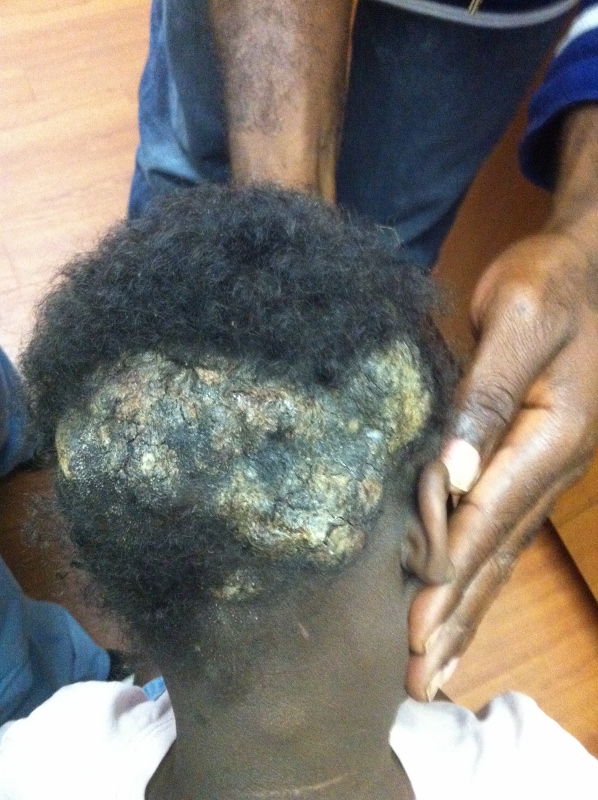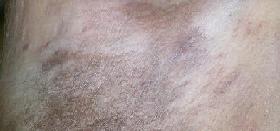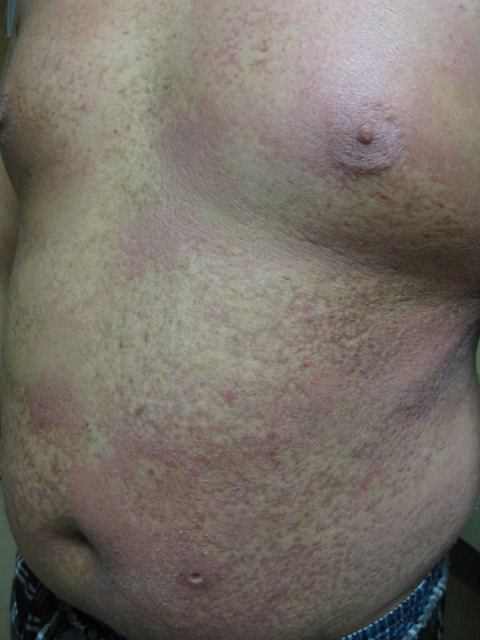CORRECT DIAGNOSIS:
KID Syndrome
DISCUSSION:
Keratosis, ichthyosis, and deafness (KID) syndrome is a congenital disorder of the ectoderm characterized by neovascularization and keratitis of the cornea, extensive ichthyosiform eruptions, and sensorineural deafness. This rare syndrome was first described in the literature in 1915 by Burns and the acronym KID was later coined in 1981 by Skinner et al to highlight the main features.
KID syndrome is an autosomal dominant condition caused by a mutation in the GJB2 gene which encodes for connexin 26 gap junction proteins. This protein is expressed in the epithelium of the cornea, inner ear, and epidermis and is critical in epithelial homeostasis and differentiation. Impairment of connexin 26 gives rise to the constellation of findings seen in KID syndrome and ultimately leads to increase susceptibility to cutaneous infections and epidermal carcinogenesis.
The extent and severity of KID syndrome are variable. Symptoms may be present at birth; however, most patients will develop well-demarcated hyperkeratotic plaques of the extremities, scalp, face and perioral region by infancy or early childhood. Sparse hair of the scalp, nail dystrophy and dental abnormalities are also common findings.
Within the past several years the follicular occlusion triad of dissecting cellulitis of the scalp, hidradenitis suppurativa and cystic acne has been recognized as a manifestation of KID syndrome. This is likely secondary to the abnormal keratinization of the epidermis leading to follicular plugging, cyst formation and eventual rupture. The resultant chronic inflammatory and granulomatous response leads to increased susceptibility to skin infections. Most infections tend to be localized, persistent and recurrent which frequently involves S. aureus, E. coli, P. aeruginosa, T. rubrum and C. albicans. There are reports of KID patients with systemic infections and even septicemia leading to death. KID patients are also susceptible to follicular tumors and squamous cell carcinomas.
Management of KID syndrome requires a multidisciplinary approach involving dermatology, ENT, and ophthalmology. Topical emollients, keratolytics, antifungals, and antibiotics tend to have limited benefits. Oral antibiotics and antifungal medications are often necessary for acute infections and prolonged courses may be required. Significant improvements in treating hyperkeratosis and symptoms of the follicular triad have been obtained with acitretin, isotretinoin, and surgical debridement. These patients should also be monitored regularly for mucosal and cutaneous malignancies.
TREATMENT:
This patient was recently placed on Terbinafine and Cephalexin. Her case was also discussed with local experts in the area and we plan on starting the patient soon on isotretinoin or acitretin.
REFERENCES:
Gonzalez, M. E., Tlougan, B. E., Price, H. N., Patel, R., Kamino, H., & Schaffer, J. V. (2009). Keratitis-ichthyosis-deafness (KID) syndrome. Dermatology Online Journal, 15(8), 11. PMID: 19725796
Miller, M. E., Henderson, F. W., Burkhart, C. N., & Morrell, D. S. (2010). Generalized xerosis and hyperkeratotic, infected scalp lesions in a 7-year-old with congenital hearing impairment. Pediatric Dermatology, 27(6), 651. https://doi.org/10.1111/j.1525-1470.2010.01203.x PMID: 20412320
Maintz, L., Betz, R. C., Allam, J. P., Wenzel, J., Jaksche, A., Friedrichs, N., Bieber, T., & Novak, N. (2005). Keratitis-ichthyosis-deafness syndrome in association with follicular occlusion triad. European Journal of Dermatology, 15(5), 347-352. https://doi.org/10.1684/ejd.2005.0009 PMID: 16228909
Wenghoefer, M., Allam, J. P., Novak, N., Maintz, L., Martini, M., & Bergé, S. (2007). Surgical therapy in a patient with keratosis-ichthyosis-deafness (KID) syndrome associated with follicular occlusion triad. European Journal of Dermatology, 17(5), 449-450. https://doi.org/10.1684/ejd.2007.0446 PMID: 17986743
Zhang, X., He, Y., Zhou, H., Luo, Q., & Li, C. (2007). Severe ichthyosis-related disorders in children: Response to acitretin. Journal of Dermatological Treatment, 18(2), 118-122. https://doi.org/10.1080/09546630701220060 PMID: 17484484
Conrado, L. A., Marques, S. A., Lastoria, J. C., Cucé, L. C., Marques, M. E., & Dillon, N. L. (2007). Keratitis-ichthyosis-deafness (KID) syndrome with squamous cell carcinoma. International Journal of Dermatology, 46(4), 403-406. https://doi.org/10.1111/j.1365-4632.2007.03190.x PMID: 17489983
Gilliam, A., & Williams, M. L. (2002). Fatal septicemia in an infant with keratitis, ichthyosis, and deafness (KID) syndrome. Pediatric Dermatology, 19(3), 232-236. https://doi.org/10.1046/j.1525-1470.2002.19204.x PMID: 12000739




